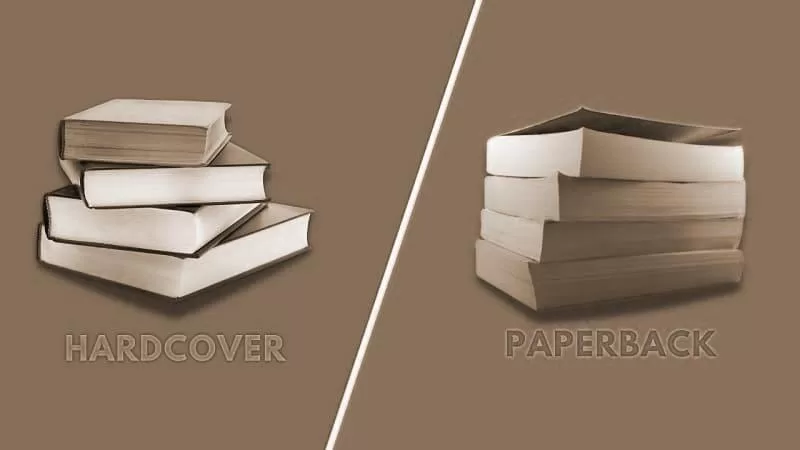
Which Do You Prefer?
Are you passionate about reading but unsure whether to choose a hardcover or a paperback edition? Weighing the pros and cons of each option can help you make an informed decision. In this article, we will explore the advantages and disadvantages of both hardcover and paperback books, leaving you more confident about which format suits your preferences.
Hardcover books offer durability and a sturdier design, making them ideal for collectors or those who value the longevity of their books. They look impressive on shelves and are less likely to be damaged in transit. On the other hand, paperback books are lightweight, portable, and more affordable, making them a popular choice for readers on the go.
We will delve into the pros and cons of each format, including factors such as cost, aesthetics, convenience, and ease of handling. By the end, you’ll have a clearer understanding of which format is better for you and your reading habits. So let’s dive in and explore the fascinating debate of hardcover versus paperback books.
Pros of Hardcover Books
Hardcover books are often lauded for their durability and sturdy construction, making them an ideal choice for avid readers and collectors alike. The hard cover protects the pages from wear and tear, ensuring that the book can withstand the rigors of repeated readings and handling. This durability also makes them a great option for those who want their books to last for years, potentially becoming cherished heirlooms. The investment in a hardcover edition can be well worth it, especially if you have a collection that you plan to maintain over time.
In addition to their physical durability, hardcover books often feature high-quality printing and binding. The paper used is typically thicker and more textured, providing a more luxurious feel when turning the pages. Many readers find this tactile experience enhances their overall enjoyment of the book. Moreover, the aesthetic appeal of a hardcover book is undeniable; they often come with beautiful dust jackets and are visually striking on a bookshelf, making them a wonderful addition to any home library.
Hardcover editions also tend to retain their value better than paperbacks. This is particularly significant for collectors and those who enjoy the investment aspect of book ownership. Certain first editions or limited releases can be appreciated over time, making them not just a source of entertainment but also a potential financial asset. For readers who appreciate the art of book collecting, a hardcover offers both beauty and a promise of longevity that is often unmatched by its paperback counterpart.
Cons of Hardcover Books
Despite their many advantages, hardcover books come with their own set of drawbacks. One of the most significant disadvantages is their price point. Hardcovers are generally more expensive than paperbacks, which can be a deterrent for casual readers or those on a tight budget. The higher cost may limit the number of books one can purchase at a time, making it harder for avid readers to build their libraries. The price can be a considerable barrier for those who enjoy reading a wide variety of genres.
Another downside is the weight and size of hardcover books. They are typically heavier and bulkier, making them less convenient for reading on the go. Carrying a few hardcovers in your bag can quickly become cumbersome, especially if you’re commuting or traveling. This weight can also pose a challenge for readers who prefer to read in bed or while lounging, as the book may become uncomfortable to hold for extended periods.
Additionally, the binding of hardcover books can make them less flexible compared to paperbacks. Many readers appreciate the ability to easily fold a paperback back on itself or to lay it flat while reading. The stiffness of a hardcover can make it more challenging to navigate while trying to find a comfortable position. This aspect can affect the overall reading experience, particularly for those who enjoy curling up with a book for long reading sessions.
Pros of Paperback Books
Paperback books have gained immense popularity due to their affordability and convenience. One of the most significant advantages is their lower price. For budget-conscious readers, paperbacks provide an accessible way to explore a wide range of titles without breaking the bank. This affordability allows readers to experiment with new authors and genres, expanding their literary horizons without a substantial financial commitment.
Portability is another strong point for paperback books. Their lightweight nature makes them easy to carry around, whether you’re commuting, traveling, or simply moving from one room to another. They fit comfortably into bags and backpacks, allowing readers to take their books anywhere without the added bulk of a hardcover. This convenience is particularly beneficial for those who enjoy reading on public transport or during breaks at work.
Lastly, paperback books’ flexibility enhances the reading experience. The ability to easily flip through pages, fold the cover back, or lay the book flat makes them a practical choice for many readers. This versatility is especially advantageous for those who like to reference specific sections while reading or for students who may need to annotate texts. The tactile experience of handling a paperback can often feel more intimate and relaxed, allowing readers to immerse themselves in the story more freely.
Cons of Paperback Books
While paperback books have numerous advantages, they are not without their downsides. One of the most prominent issues is their overall durability. Paperbacks are generally more susceptible to damage, such as creasing, tearing, or yellowing pages. For readers who frequently travel or move, this fragility can be a significant concern. A paperback may not survive the wear and tear of being shoved into a bag or tossed around during travel, which can lead to disappointment for those who cherish their books.
Additionally, the quality of paper used in paperbacks often falls short compared to hardcovers. The pages can be thinner and less textured, which may affect the reading experience for some. The ink might bleed through more easily, particularly if the book is printed on lower-quality paper. This can detract from the overall enjoyment of the book, especially for those who appreciate a more refined and luxurious reading experience.
Another drawback is the limited lifespan of paperback books. They tend to wear out more quickly, which can be frustrating for avid readers who want to revisit their favorite titles over the years. The binding may loosen, pages might fall out, or the cover may become damaged. For those who value longevity in their book collection, this aspect can make paperbacks less appealing, despite their lower initial cost.
Factors to Consider When Choosing Between Hardcover and Paperback
When deciding between hardcover and paperback books, several key factors should be taken into account. First and foremost is your reading habits. If you frequently read on the go or enjoy taking your books with you to various locations, the portability of paperbacks may be a crucial advantage. Conversely, if you prefer to read at home and appreciate the aesthetic of a well-organized bookshelf, hardcovers might be more appealing. Understanding your lifestyle can significantly influence your choice.
Cost is another significant consideration. If you are an avid reader who consumes multiple books each month, the cumulative cost of hardcovers can quickly add up. In contrast, paperbacks can offer the flexibility to explore a broader range of titles without financial strain. Weighing the importance of budget versus personal preferences can help clarify which format suits you best.
Lastly, consider your approach to book collecting. If you view books as investments or cherish the idea of building a beautiful library, the durability and visual appeal of hardcover editions might be more aligned with your goals. However, if your focus is primarily on reading and enjoying stories without the need for long-term preservation, the affordability and convenience of paperbacks may be the better option. Reflecting on these factors can guide you toward the right decision for your reading journey.
The Impact of Book Format on Reading Experience
The format of a book can significantly influence the reading experience, affecting how readers engage with the text. Hardcover books, with their robust bindings and high-quality materials, often provide a sense of occasion and importance. The tactile nature of a hardcover can enhance the feeling of immersing oneself in a story, making readers feel more connected to the work. Many readers enjoy the ritual of holding a substantial book, which can evoke a sense of nostalgia and create a more meaningful reading experience.
In contrast, paperback books often promote a more casual and accessible reading experience. The lightweight and flexible nature of paperbacks makes them easy to handle, allowing readers to transition between different reading positions without discomfort. This can encourage longer reading sessions, as readers can easily find a comfortable way to engage with the text. The ease of flipping through the pages can also make it simpler to revisit favorite sections or passages, fostering a more interactive relationship with the book.
Moreover, the format can impact how readers perceive the content. A hardcover may give the impression of a more serious or prestigious work, while a paperback might suggest a more approachable, casual read. This perception can influence expectations, affecting their enjoyment and engagement with the material. Ultimately, the choice of format can shape the physical experience of reading and the emotional and cognitive connections that readers develop with the stories they love.
Popular Genres and Their Preferred Book Formats
Different genres often lend themselves to specific formats based on reader preferences and the nature of the content. For instance, literary fiction and classic literature are frequently found in hardcover editions. Readers often appreciate the aesthetic value of these books on their shelves, and the durability of hardcovers makes them ideal for works that are commonly revisited over time. The quality of the binding and paper can enhance the reading experience, allowing readers to savor the language and depth of these texts.
On the other hand, genres like romance, thrillers, and contemporary fiction are often popular in paperback format. The affordability and accessibility of paperbacks make them a go-to choice for readers who enjoy consuming these fast-paced stories. Many readers prefer to carry a paperback while commuting or traveling, making these genres particularly suited for the portable nature of the format. Additionally, the casual approach to these genres often aligns with the flexibility of paperbacks, allowing readers to easily dive in and out of the stories.
Graphic novels and illustrated books also have unique considerations when it comes to format. Many readers prefer hardcovers for these types of books, as the high-quality printing and binding can better showcase the artwork. The durability of a hardcover ensures that the illustrations are preserved, allowing readers to appreciate the visual storytelling fully. Ultimately, the genre of a book can play a significant role in determining its preferred format, as readers seek the best experience based on their interests and reading habits.
Sustainability and Environmental Considerations
In recent years, sustainability has become an increasingly important consideration for consumers across various industries, including publishing. When evaluating hardcover and paperback books, environmental impact can play a crucial role in the decision-making process. Paperbacks typically have a lower carbon footprint due to their lighter weight and simpler production processes. The use of recycled paper in many paperback editions can also contribute to a more sustainable reading option, appealing to environmentally conscious readers.
However, the durability of hardcover books can also be viewed through a sustainability lens. While they may have a higher upfront environmental cost due to the materials used in their production, their longevity means they can be read and enjoyed for many years, reducing the need for replacements. For readers who value long-term use and the potential for sharing or gifting books, hardcovers can be seen as a more sustainable choice in the long run.
Additionally, the rise of digital reading options has introduced another layer to the sustainability conversation. E-books eliminate the need for physical materials, but they come with their environmental concerns related to electronic waste and energy consumption. Readers must weigh the pros and cons of each format, considering not only their personal preferences but also their impact on the planet. Ultimately, the choice between hardcover and paperback books can reflect a reader’s values and commitment to sustainability in their reading habits.
Conclusion: Making the Right Choice for You
Navigating the debate between hardcover and paperback books ultimately comes down to personal preference and individual reading habits. Each format offers its own unique set of advantages and disadvantages that cater to different types of readers. For those who prioritize durability, aesthetics, and long-term investment, hardcover books may be the ideal choice. Their robust construction and visual appeal can enhance the overall reading experience while allowing readers to build a beautiful library.
Conversely, if portability, affordability, and ease of handling are more aligned with your lifestyle, then paperbacks may be the better fit. Their lightweight nature and lower price point make it easier to explore a wide variety of titles without compromising on enjoyment. For many readers, the freedom to experiment with different genres and authors leads to a richer literary experience.
Ultimately, the best choice is the one that aligns with your reading habits, preferences, and values. Whether you choose hardcover or paperback, the joy of reading remains at the heart of the decision. Embrace your unique reading journey and enjoy exploring the countless stories that await you, regardless of the format you choose.















































































































